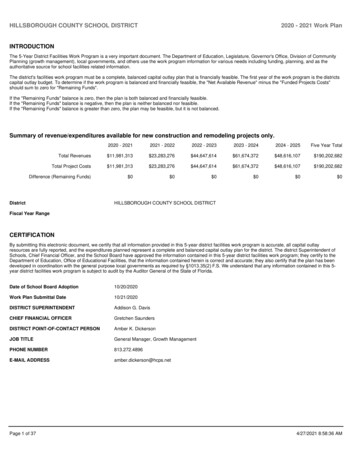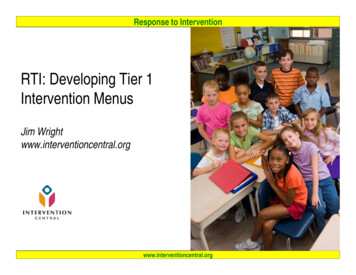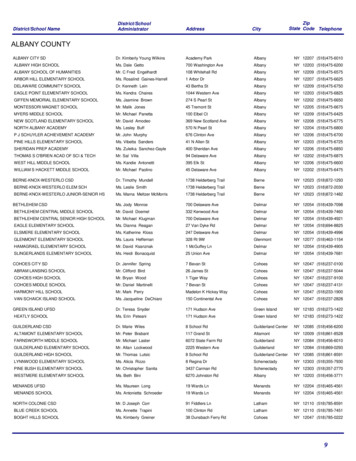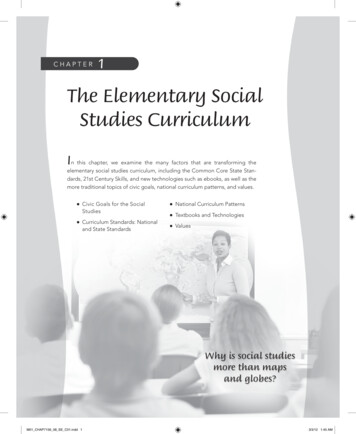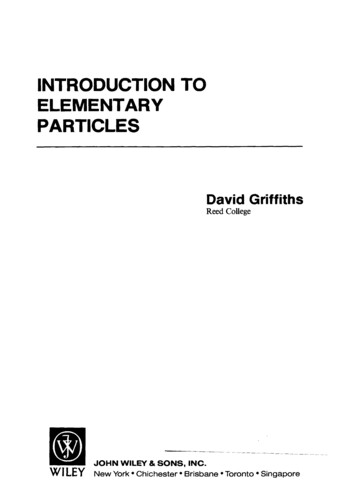
Transcription
Elementary Social Studies: A Practical Approach to Teaching and Learning,Seventh EditionWright/HutchisonActivity Ideas forElementary Social StudiesContributed by Beginning Teachersin the Faculty of Education, Brock Universityto the Social Studies Activity Database, 1999-2008Edited by David HutchisonCopyright 2010 Pearson Education Canada, a division of Pearson Canada Inc., Toronto, Ontario. All rights reserved.This work is protected by Canadian copyright laws and is provided solely for the use of instructors in teaching theircourses and assessing student learning. Dissemination or sale of any part of this work (including on the Internet) willdestroy the integrity of the work and is not permitted. The copyright holder grants permission to instructors who haveadopted Elementary Social Studies: A Practical Approach to Teaching and Learning, Seventh Edition byWright/Hutchison to post this material online only if the use of the website is restricted by access codes to students inthe instructor’s class that is using the textbook and provided the reproduced material bears this copyright notice.
Elementary Social Studies: A Practical Approach to Teaching and Learning,Seventh EditionWright/HutchisonActivity Ideas for Elementary Social StudiesIntroductionSince 1999, hundreds of beginning teachers in the teacher education program at BrockUniversity (Ontario, Canada) have each year contributed an original or adapted socialstudies activity idea to a searchable database that is publicly available at this website:http://www.ed.brocku.ca/ soc/dbase.htmlThis year marks the 10th anniversary of this initiative and to celebrate the milestone weare pleased to be working in cooperation with Pearson Education Canada to bring thisfree electronic book of beginning teacher-contributed activity ideas to an even widerreadership.With well over 1500 activities in the social studies activity database – and even morebeing added every year – it was not possible to include every contributed activity in thebook. I hope this selection of activities, covering the full breadth of the elementary years,will inspire readers to try out and adapt, as appropriate, the lesson ideas they find insidethis book.For the most part, the activities are presented "as is," as they were submitted to theelectronic database. Occasionally, a few character symbols did not translate over andeach activity is formatted slightly differently (as each was contributed by a differentauthor). The reader may also come across the occasional spelling or sentence structureerror, but, on the whole, this should not diminish the pedagogical value of the activitiesand their merit as lesson ideas for social studies teachers across Canada. (Keep in mind,however, that the activities in the book are presented with the Ontario curriculum inmind. Teachers in other provinces and territories will need to adapt the activities to suittheir own particular teaching contexts.)To make best use of this book, I don't recommend reading it from cover to cover. Insteaduse the search function that is built into your PDF reader to search for the grade, topic, orkeywords that most interest you.Happy reading and happy teaching And thanks to the hundreds of beginning teachersat Brock University who have contributed to the social studies activity database over thelast ten years.David Hutchison, Ph.D.Associate ProfessorFaculty of EducationBrock Universitydavid.hutchison@brocku.ca 2010 Pearson Education Canada2
Elementary Social Studies: A Practical Approach to Teaching and Learning,Seventh EditionWright/HutchisonActivity Ideas for Elementary Social StudiesAcknowledgementsThe activity plans that the editor (David Hutchison) has submitted for incorporation intothis free downloadable PDF document at the Text Enrichment Website for ElementarySocial Studies, 7th edition, were submitted between 1999 and 2008 to a social studiesactivity database by teacher candidates in the teacher education program at BrockUniversity using an online submission form. Used with permission. 2010 Pearson Education Canada3
Elementary Social Studies: A Practical Approach to Teaching and Learning,Seventh EditionWright/HutchisonActivity Ideas for Elementary Social StudiesTable of ContentsGrade 1Relationships, Rules, and Responsibilities . 5The Local Community . 59Grade 2Features of Communities Around the World. 131Traditions and Celebrations . 174Grade 3Early Settlements in Upper Canada . 239Urban and Rural Communities . 280Grade 4Canada’s Provinces, Territories, and Regions . 308Medieval Times . 394Grade 5Aspects of Citizenship and Government in Canada . 469Early Civilizations . 527Grade 6Canada’s Links to the World . 586First Nation Peoples and European Explorers . 615Grade 7British North America. 665Conflict and Change . 675Natural Resources . 678New France . 688Patterns in Physical Geography . 694The Themes of Geographic Inquiry. 703Grade 8Canada: A Changing Society . n/aConfederation. 711Economic Systems . 722Migration. 726Patterns in Human Geography . 729The Development of Western Canada . 748Additional Activity Ideas. 754 2010 Pearson Education Canada4
Elementary Social Studies: A Practical Approach to Teaching and Learning,Seventh EditionWright/HutchisonActivity Ideas for Elementary Social StudiesContributor: M. ArliaGrade: 1Topic: Relationships, Rules, and ResponsibilitiesKeywords: Community Study, Drama, Personal GrowthTime: Over 60 MinutesStudent Grouping: Small GroupExpectations:1. Students will identify and describe the rights and responsibilities of people in thecommunity.2. Students will identify rules in the home, at school and the community.3. Students will work cooperatively within their groups.4. Students will respect the responses of their peers.5. Students will show creativity in their role playing.Teacher Materials:3 flash cards of pictures of people from the neighbourhood (for example, fireman,policeman, priest, etc.)3 flash cards of the people's names (the words: fireman, policeman, priest, etc.)3 flash cards of places in the community where the people could be found (for example,fire station, police station, church, etc.)3 flash cards of the people's responsibilities (for example, "Who helps to put out fires?"etc.)3 flash cards of rules for the places (for example, "Listen to the firemen!" etc.)list of prearranged groupsStudent Materials:30 flash cards of pictures of people from the neighbourhood (for example, fireman,policeman, priest, etc.)30 flash cards of the people's names (the words: fireman, policeman, priest, etc.)30 flash cards of places in the community where the people could be found (for example,fire station, police station, church, etc.)30 flash cards of the people's responsibilities (for example, "Who helps to put out fires?"etc.)30 flash cards of rules for the places (for example, "Listen to the firemen!" etc.)Sequence:Preparation: 2010 Pearson Education Canada5
Elementary Social Studies: A Practical Approach to Teaching and Learning,Seventh EditionWright/HutchisonActivity Ideas for Elementary Social Studies1. Choose 33 people and places from our neighbourhood that the children will learnabout.2. Make 33 flash cards with a picture of the people chosen.3. Make 33 flash cards with the names of the people chosen.4. Make 33 flash cards with the names of the places chosen.5. Choose one responsibility for each of the people chosen.6. Make 33 flash cards of the responsibilities.7. Choose one rule for each place chosen.8. Make 33 flash cards for the rules.Activity:1. Move to the carpet area of our classroom.2. Ask the children what a responsibility is and talk about it.3. Have the children give a few examples of responsibilities that they have in their lives.4. Show one of the people flash cards and ask what one responsibility is that that personhas.5. Have one student match the person card with the responsibility flash card.6. Do two additional examples of responsibilities with the class.7. Ask the children what a rule is and talk about it.8. Have the children give a few examples of rules that they follow in their lives.9. Show one of the place cards that was chosen and ask what one rule is that the childrenneed to follow when they are in that place.10. Have one student match the place card to the rule flash card.11. Do two more examples of rules with the class.12. The students will be put into prearranged groups of 3.13. They will be given 3 people flash cards, 3 people's names flash cards, 3 place flashcards, 3 responsibility flash cards and 3 rule flash cards that they will match.14. We will gather again on the carpet and discuss the matches that the children made.15. The students will go back to their groups and create a skit with the people and placesthat they have. They will focus on the responsibilities and rules that they have on theirflash cards.16. The students will present their skits in front of the class.17. We will review all of the responsibilities and rules that we discussed.18. After we finish, we will put all of the people, responsibilities, places and rules up onthe bulletin board.Application:This activity can be integrated into the wider curriculum by generalizing and expandingupon the rules and responsibilities that werediscussed. It is useful to teach children about rules and responsibilities because they areimportant life skills which are used in manydifferent aspects of the children's lives (at home, at school, etc.).This activity could be adapted for older children by changing the people. The activitycould include important people from history and 2010 Pearson Education Canada6
Elementary Social Studies: A Practical Approach to Teaching and Learning,Seventh EditionWright/HutchisonActivity Ideas for Elementary Social Studiesvarious parts of the world. More rules and responsibilities could be incorporated into theactivity (for example, more complex rules forolder children).The children's skits could be combined to form a class play of people in the community.The play could either be videotaped orperformed for other classrooms and parents.Notes: 2010 Pearson Education Canada7
Elementary Social Studies: A Practical Approach to Teaching and Learning,Seventh EditionWright/HutchisonActivity Ideas for Elementary Social StudiesContributor: J. BiagiGrade: 1Topic: Relationships, Rules, and ResponsibilitiesKeywords: Community Study, Controversy, Environmental Education, Feelings, InquirySkills, Language Arts, Personal Growth, Social ActionTime: 45 MinutesStudent Grouping: Full ClassExpectations:CURRICULUM EXPECTATIONS:1. Students will create simple timelines to describe changes over time.2. Students will describe the roles and responsibilites of various people in theirneighbourhood.RELEVANT COGNITIVE, AFFECTIVE, SKILL OBJECTIVES:1. Students will identify all four seasons.2. Students will articulate the differences between each season.3. Students will display organizational skills.Teacher Materials:* Homemade spinning wheel* Flash cards (containing pictures and few words pertaining to each season)* Tape* Chalk board* Pre-made timeline bannerStudent Materials:Sequence:Preparation:1. The teacher will create a homemade spinning wheel that contains an arrow in themiddle and each of the four seasons listed on the outer part of the wheel.(This wheel should be taped onto the chalk board prior to the beginning of the lesson).2. The teacher will pre-select specific pictures pertaining to each season. The teacher willaffix each picture onto a flash card.(These pictures will be mixed around and taped onto a designated area on the chalkboard).3. The teacher will create a timeline banner which will contain each of the seasons insequential order.(The timeline should be taped on the chalk board prior to the beginning of the lesson). 2010 Pearson Education Canada8
Elementary Social Studies: A Practical Approach to Teaching and Learning,Seventh EditionWright/HutchisonActivity Ideas for Elementary Social StudiesActivity:1. The activity will occur in the classroom.2. The teacher will introduce the lesson through an evaluation method. In doing so, theteacher will gain insight about what the students already know about the topic.This method will be completed through verbal questioning about general and basicconcepts about the topic.3. Next, the application process will occur in which the teacher will select ONE student ata time to go to the chalk board to spin the wheel.WHEEL:l Springl / nterl4. When the wheel has stopped on a particular season, the student must go to thedesignated area on the chalk board which contains the flash cards and pick only ONEpicture that they think relates to that particular season. The flash cards will have severaldifferent pictures.The categories of pictures will be:Activites pertaining to each swimming/playing soccer,baseball/suntanning/building sand castlesFall----------------rake leaves/HalloweenWinter------------building snowmen/playing in snow/playing hockey/skating/ChristmasWeather type/ physical changes:Spring------------cool, rainy, flowers and trees begin to budSummer----------hot, sunnyFall----------------cool, leaves falling, leaves changing colourWinter------------snow, coldTypes of clothing:Spring------------short sleeve shirt, shorts, rain coatSummer----------shorts, tank tops, bathing suits, sandlesFall----------------long sleeve shirts, pants, jacketWinter------------sweater, pants, boats, scarf, mitts, hat, snowsuit 2010 Pearson Education Canada9
Elementary Social Studies: A Practical Approach to Teaching and Learning,Seventh EditionWright/HutchisonActivity Ideas for Elementary Social StudiesMembers of the community related to each fe guardFall---------------individual raking leavesWinter-----------Snow plower5. After the student has made their choice, they will go to the timeline banner and placethe choosen picture anyApplication:This activity can be adapted for use by most age groups. For older students the teachercan have them brainstorm descriptive words rather then having pre-selected pictures. Inaddition, the teacher could split the class into four groups (each group representing aseason) and having a debate.The 'verbal' feedback method elminates any fears that students may have about choosingthe 'wrong answer'. This activity can also be modified to meet the needs of students withphysical disabilites simply by dividing the class into four groups (each representing aseason) and providing each group with their own spinning wheel and timeline. Theanswers can then be discussed as a class and students can compare simiarities anddifferences from each group.This activity can be used to introduce several different topic areas. For instance, it canintorduce the topic of 'time', the topic of 'days, months, and years', and the topic of'weather'.There are several activites that extend from this particualr activity. For example, you maywish to use the exact same activity and simply change the topic area (such as livingthings). In addition, you can have students debate about specific seasons. Students couldalso make lists or discuss in groups how each season influences their dress, dailyactivites, their responsibilites at home and school.It is important to note that before this lesson is taught, student need to have priorknowledge about basic and general definitions. Students need to know what a season is,how many seasons there are, what the name of each season is and the duration of eachseason.This activity definitely fits within the larger context of the elementary curriculum becauseit can easily be modified to meet the expectations of all grade levels as well as beingeasily modified for various topic areas.Notes:This activity is adapted from professor Hutchison's in class activity associated withmembers of the community and the roles that they have within the community. 2010 Pearson Education Canada10
Elementary Social Studies: A Practical Approach to Teaching and Learning,Seventh EditionWright/HutchisonActivity Ideas for Elementary Social StudiesContributor: S. CodeGrade: 1Topic: Relationships, Rules, and ResponsibilitiesKeywords: Community Study, Human Geography, Inquiry Skills, Maps,Multiculturalism, Personal Growth, Physical GeographyTime: 45 MinutesStudent Grouping: IndividualExpectations:1. Students will identify important relationships in their lives.2. Students will construct a chart and use appropriate vocabulary within the chart todescribe their observations.3. Students will demonstrate an understanding that communities are made up of manydifferent cultures.4. Students will use primary and secondary sources to locate information aboutrelationships in their home.Teacher Materials:Large MapLetter to be handed out to parents(informing parents of activity)Student Materials:30 sheets of paper for chart(pencils, rulers, erasers etc)30 Map handoutsPencil Crayons (30 packages, one for each student)Package of Sticky Notes (with at least 150 sticky notes)Sequence:This activity has been adapted from a book entitled ìHands-On Social Studiesî. In thecurrent grade one curriculum, there is a requirement to study Heritage and Citizenship.Within this context, Students will be looking at relationships (Friends, Family etc), rulesand responsibilities. To help students better understand their families, as well as others,we will be discussing the different relatives the kids have.Preparation:-A letter must be made in advance for the parents of the students as they will be anintegral part of accomplishing our goal-World Maps for students must also be made up ahead of time (not too complicated)Activity: Session 1 2010 Pearson Education Canada11
Elementary Social Studies: A Practical Approach to Teaching and Learning,Seventh EditionWright/HutchisonActivity Ideas for Elementary Social Studies1. Have the students list as many family members as they can think of (Mothers, Fathers,Siblings, Aunts/Uncles, Grandparents, extended family and other significant people).2. Once the list of family members have been made up, the students will create a chartwhich lists the family memberís name, their relation to the student and the familymemberís Country of origin (If no family memberís are from out of the Country, the childmay use provinces, or cities if need be). One can be made on the front board so thestudents may copy it.3. Each student will act as a detective to investigate their family origins. They will berequired to take their chart home and ìinterviewî their parents to find out where eachrelative came from. A letter should be made for the students to take home to their parentsso they can help their son/daughter fill in the chart. They will then write down all theirinformation on the chart. {For more advanced grades you could have the students tallythe number of people that come from each Country and then they could graph theirresults}.Activity: Session 24. When all the information has been compiled, each child will be given sticky notesplaced on a sheet of paper (amount should correspond to how many relatives are listed ontheir sheet). Either the child or the teacher will write a family memberís relation to thestudent on the sticky note, depending how far along in the year the kids are, or how largethe sticky notes are (eg. ìSallyís Auntî).5. Once all the sticky notes are filled in, the kids will all meet in a circle on the carpet.We will discuss where our relatives come from and why it is important.6. One at a time we will have the students place their sticky notes on a large world map(with obvious help).7. The students will be given a labelled world map handout. They can colour in all theCountries that their classmates and their own relatives originate from (while the map isstill up with all the sticky notes on it).8. If there is extra time, they may even use a specific colour to correspond to a specificperson in the class, so all of Countries that Sallyís relatives come from may be in blue,while Bobbyís are in green. The students may even make it their goal to meet as manydifferent people from different parts of the world throughout the coming months so theyApplication:This activity can be integrated into many parts of the curriculum. If we were to tally allthe different Countries that all the family members come from, we would be able to graphour results which would coincide with the math curriculum. This might be much forgrade One but we can definitely have the Students count how many relatives are from aspecific Country. This lesson also deals quite a bit with geography, but at this age, thereis no geography curriculum yet, so this is more of an introduction to geography. Thecolouring activity could also be integrated with visual arts curriculum. As mentionedpreviously, there are other activities that can draw on this activity, such as the namehistory. Students could even make up their own family coat of arms. We could also 2010 Pearson Education Canada12
Elementary Social Studies: A Practical Approach to Teaching and Learning,Seventh EditionWright/HutchisonActivity Ideas for Elementary Social Studiesincorporate language arts by having them write in their journal why their family isimportant and what we all learn by having such diverse backgrounds. This activity ismore of an introduction to geography, prior knowledge of the world map would beuseful, but is not needed. Knowledge of what a family is and who makes up a family maybe needed, but it can be discussed in the first session.Notes:This activity is adapted from the "Cultural Origins of Family Members" activity inJennifer Lawson's book "Hands-On Social Studies" (Winnipeg, Manitoba: Portage andMain Press, 2001). 2010 Pearson Education Canada13
Elementary Social Studies: A Practical Approach to Teaching and Learning,Seventh EditionWright/HutchisonActivity Ideas for Elementary Social StudiesContributor: L. DumitruGrade: 1Topic: Relationships, Rules, and ResponsibilitiesKeywords: Language Arts, MapsTime: 45 MinutesStudent Grouping: PartnerExpectations:1. Students will locate the position of a geometric shape in their classroom and itscorresponding position on a topographical map.2. Students will orally describe the location in their classroom where the shape wasfound.3. Students will use appropriate vocabulary to orally describe their observations.4. Students will classify information according to shape and size.Teacher Materials:15 large construction paper cutouts of geometric shapes (20cm in diameter)15 small duplicates of the shapes (4cm in diameter)1 large piece of graph paper1 masking tape1 dark blue markerStudent Materials:15 cue cardsSequence:Preparation:1. Write a clue on the 15 cue cards that will enable the students to locate a hidden shapein the classroom, and indicate the names of the two students who will be partners.2. Place a cue card underneath the chairs of 15 students in the classroom.3. Place the large shapes in the location of the classroom described on the cue cards.4. Draw a topographical map of the classroom using a large piece of graph paper.5. Place the topographical map in the center of the carpet in the classroom.Activity1. The teacher will tell students that they are going to be investigators and that they needto look underneath their chairs to see if they can find a clue about the mystery.2. Have the students join the teacher on the carpet in a circle around the topographicalmap. 2010 Pearson Education Canada14
Elementary Social Studies: A Practical Approach to Teaching and Learning,Seventh EditionWright/HutchisonActivity Ideas for Elementary Social Studies3. Have them locate their position in relation to the topographical map.4. Have the students that had a card under their chairs, read the information on the cardaloud to the class.5. The students will then be asked to identify the clue and the name of their partner.6. Have the students, who are partners, sit beside each other.7. Have the students read the clue on the card again to ensure that both partners knowwhere to search for the hidden shape.8. Have the pairs of students begin their search for the shape.9. Direct the students to return to their spot on the carpet after they have located theshape.10. Have the students place a smaller version of their shape on the topographical map toindicate the place where the large shape was found.11. Have the activity continue until all the pairs locate their shape, or until 25 minuteshave elapsed.12. Have all the students return to the carpet and sit around the topographical map, if theyhave not already done so.Discussion1. Starting at one point in the circle, have each student, in turn, orally describe the placewhere their shape was found.2. Ask each student to orally describe other objects that they saw near the place wherethey located their shape.3. Collect the large shapes and the cue cards from the students.Application:This activity requires that the students have prior knowledge of locating places in theclassroom on topographical maps, and that the students will be able to describe thoseplaces orally.This activity can be extended by introducing mathematics concepts. Tally marks can beused to record the number of each shape used in the activity. A graphical representationcan be made to illustrate the most and least number of shapes that were located in theclassroom. The area of each shape could be determined using non-standard units likepennies or paper clips. The activity can also be extended as to location, by changing thesetting from the classroom to the playground, for example.The activity can be introduced in other primary and junior grades by adapting theatmosphere in the classroom. Adaptations that can be made for a grade 3 or 4 classroominclude having the classroom set up like a pioneer village or settlement, or a medievalcommunity respectively. Students would prepare a topographical map of the setting andthen compare it to their own community. To ensure that the activity remains ageappropriate, the items needing to be located, and the atmosphere in the classroom, wouldrelate to the topic of study. 2010 Pearson Education Canada15
Elementary Social Studies: A Practical Approach to Teaching and Learning,Seventh EditionWright/HutchisonActivity Ideas for Elementary Social StudiesNotes:This activity is adapted from the third activity listed on the handout, "Grade One ActivityIdeas," for EDUC 8Y39, regarding topographical map preparation. 2010 Pearson Education Canada16
Elementary Social Studies: A Practical Approach to Teaching and Learning,Seventh EditionWright/HutchisonActivity Ideas for Elementary Social StudiesContributor: J. FraserGrade: 1Topic: Relationships, Rules, and ResponsibilitiesKeywords: Arts, Community Study, Language Arts, Media Literacy, Personal Growth,Social ActionTime: 45 MinutesStudent Grouping: PartnerExpectations:Expectations:1.The student will identify the occupations of some people in the community (e.g.,caregiver, teacher, farmer, grocer, office worker, police officer) (1z31).2.The student will identify buildings in their community and their uses (e.g., houses,schools, farms, grocery store, office buildings, police station)(1z30).3.The student will be able to recognize and name the primary colours of pigment (red,blue, yellow)(1a29).4.The student will identify, in a plan, the subject matter and tools and materials they willuse to produce an art work (1a36).5.The student will be able to allow others to speak, and wait their turn in conversations orclass discussions (1e55).6.The student will be able to present ideas in speech in a coherent sequence (1e51).Teacher Materials:Teacher:22 of yellow and 20 each of brown and black, 8 x 8 felt squares5 each of round, oval and triangle shaped felt pieces, in flesh, yellow, brown, and blackcolours5 balls of yarn, one of each in the following colours, red, blue, yellow, white, black1 role of sewing bindingg
Social Studies, 7th edition, were submitted between 1999 and 2008 to a social studies activity database by teacher candidates in the teacher education program at Brock University using an online submission form. Used with permission.
